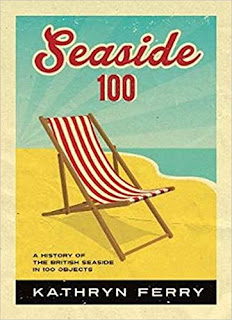Published by Unicorn Publishing
What do you think of when you think of the British seaside? Sandcastles? Donkeys? Ice cream? Punch and Judy? Fish and chips? Bathing belles? What do I think of? All of the above, plus beach huts, grand hotels, bandstands, lidos, Clevedon Pier and the De La Warr Pavilion. There could be a hundred things, the features that sum up the seaside and embody its history, and they’re all here, given a couple of pages each, in Kathryn Ferry’s new book, Seaside 100.
They make a varied bunch, but they hang together because of their common theme. And although the book’s one hundred short sections make it look a bit like a selection box that you can dip in and out of, they actually build into a historical picture of the seaside, from its beginnings with the health resorts, bathing machines, and excursion trains of the 18th and 19th centuries to the conserved piers, art galleries, and seafront sculptures of today.
There is a great deal of research crammed into this short book, but its author’s learning is worn lightly and her text is liberally sprinkled with well chosen pictures that lend visual atmosphere as well as being informative in themselves – old railway posters, historic images of holiday camp chalets, or the Blackpool illuminations, or pierrots. I found myself often surprised by what I was learning – about 18th-century seaside voyeurs looking at bathers through telescopes, about the ubiquity of bedbugs in lodging houses, about the varied designs of bathing machines, or about the early history of seaside donkeys or suntan lotion. I was pleasurably reminded, too, of things I’d forgotten, like the way in which lodging house guests used to bring their own food, which the landlady cooked for them, or how the first railway-carriage buildings were not bungalows but Victorian fishermen’s net stores. And I was grateful to Kathryn Ferry for answering questions I’d never asked. Who did write ‘I do like to be beside the seaside’, for example. It was one of those tunes I’d just taken for granted (like the circus clown’s anthem, ‘The Entry of the Gladiators’*). Now I know the answer.
Many readers of this blog are British, and people for whom the seaside is part of their childhood and heritage. Such readers will find much to entertain, amuse, and enlighten them in Seaside 100. So too will anyone with an interest in seaside architecture, and that includes amusement arcades and ice cream parlours as well as the buildings that are now regarded as the sophisticated legacy of seaside modernism – streamlined lidos, apartment blocks that look like ocean liners, Morecambe’s Midland Hotel, and, yes, Bexhill’s De La Warr Pavilion. There is more to be said of these buildings than Kathryn Ferry has room for here, but she ensures that they take their place in this attractive survey of what makes the seaside distinctive. If like me you live far from the sea and want a breath of fresh salty air and seaside history, I’d recommend ordering this book, getting in some social distanced fish and chips from your local take-away, and soaking up the atmosphere. If you're by the sea already, the book will add to your enjoyment too.
- - - - -
* And, for that matter, who wrote ’The Entry of the Gladiators’? Bouncing Czech march and polka king Julius Fučik, that’s who. Thanks to the musician-friend who told me. But he didn't write ‘I do like to be beside the seaside’. Get hold of Kathryn Ferry’s book to find out about that song.

Thank you. The seaside was a VERY special part of my childhood and heritage, but that is because I am Australian. In the summers I lived in the UK, it wasn't sunny enough for suntanning. So I went out of my way to examine seaside architecture, mainly Deco: lidos, ocean liner block of flats, hotels and De La Warr Pavilion.
ReplyDeleteAs well as Seaside 100, I recommend Art Deco by the Sea (by Ghislaine Wood).